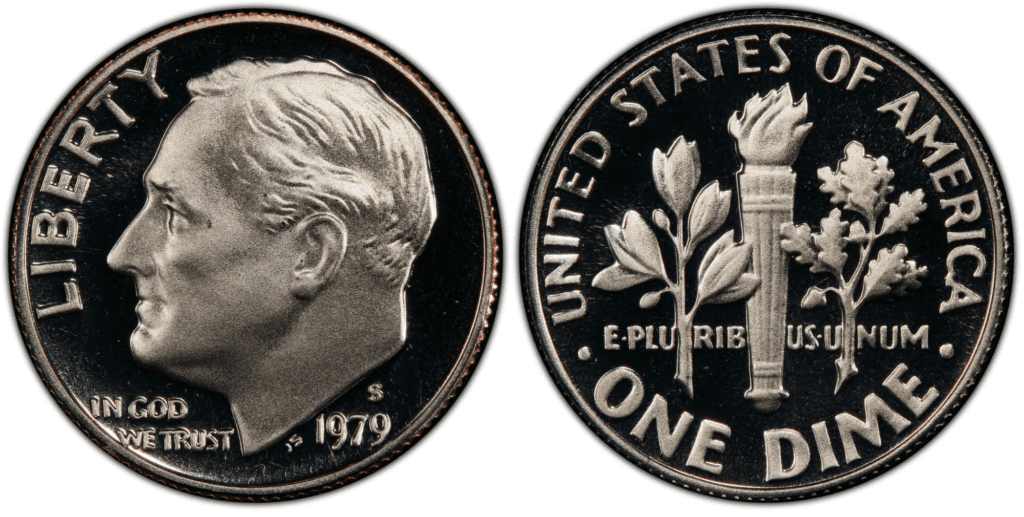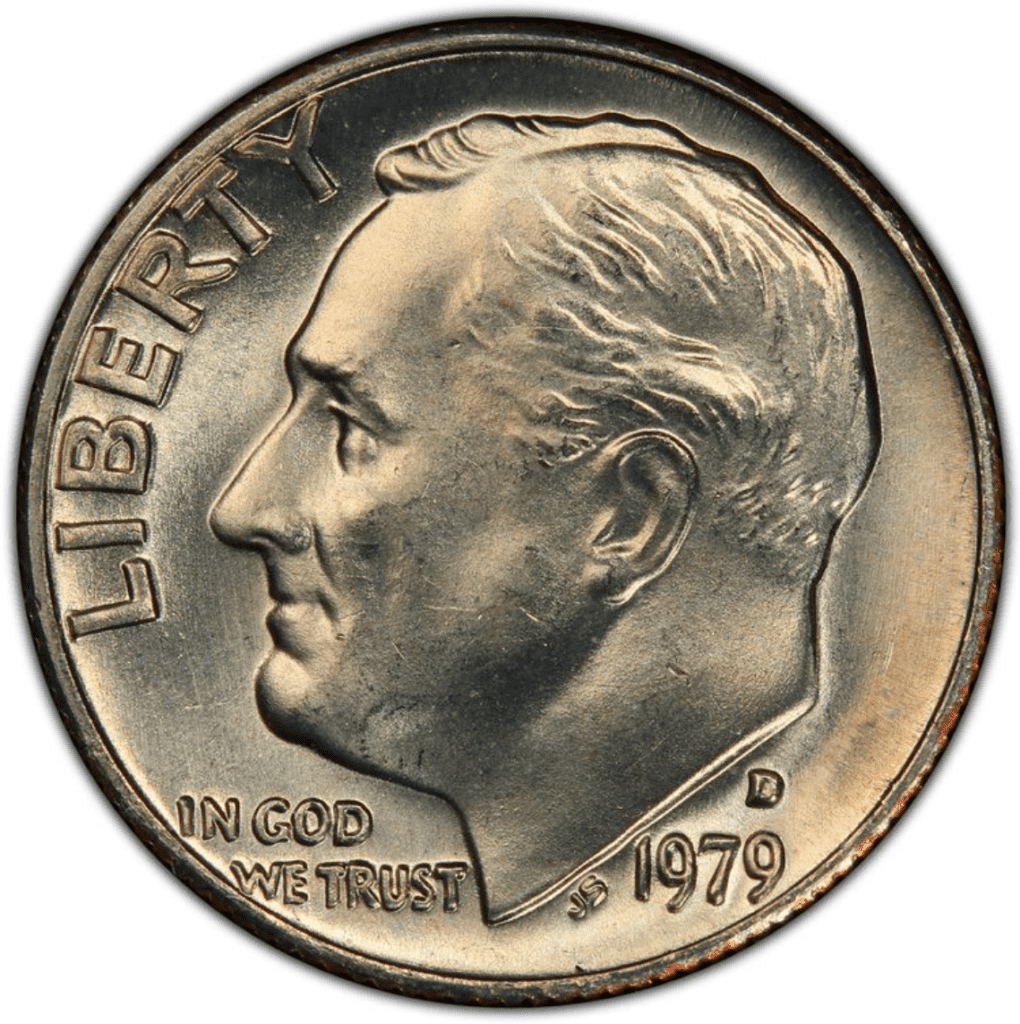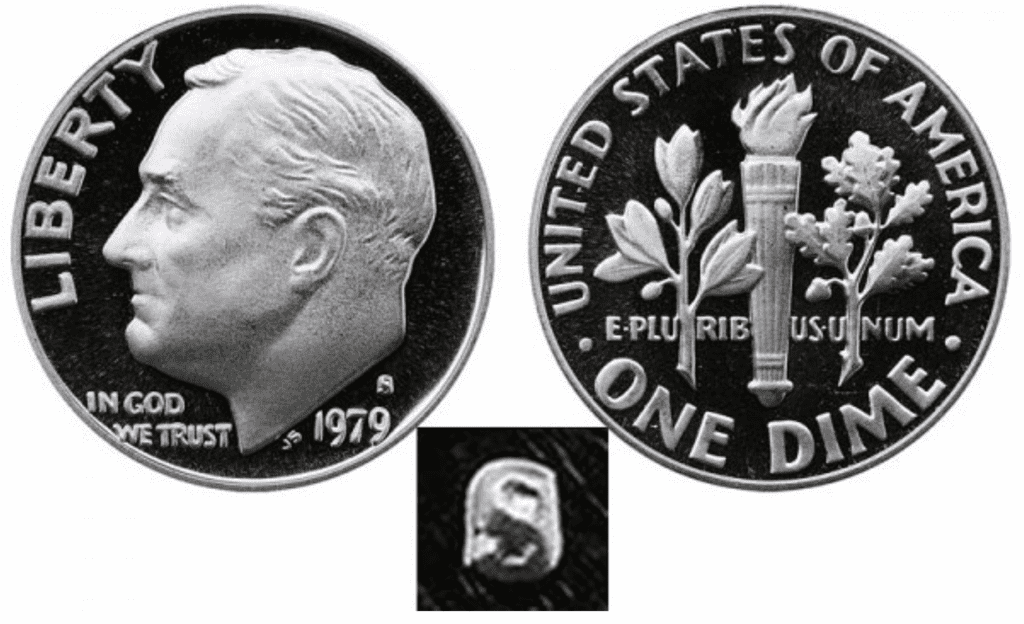What Is A 1979 Roosevelt Dime Made Of?
The 1979 Roosevelt dime is made of 91.67% copper and 8.33% nickel. It has a face value of $0.10, a mass of 2.268 grams, a diameter of 17.91 mm, and a thickness of 1.35 mm. Its edge comes with 118 reeds.
John R. Sinnock designed the Roosevelt dime. He was the Chief Engraver who submitted his design in 1946. Franklin Roosevelt died in 1945 and the new dime design was chosen to honor his contribution to the country.
However, you may wonder, why choose the dime? This was inspired by Roosevelt’s role in creating the National Foundation for Infantile Paralysis, which was later renamed the March of Dimes.

As its name suggests, the Roosevelt dime bears the left profile of the face of Franklin D. Roosevelt who served as the 32nd president of the United States. Aside from the image of Roosevelt, the obverse also comes with the following inscriptions:
- LIBERTY
- IN GOD WE TRUST
- 1979 (year of minting)
- Mint mark (can be D, S, or not present)
- JS (the initials of John Sinnock who designed the dime)
On the reverse, you will find the liberty torch at the center. On its left side is an olive branch, which symbolizes peace. On the right side of the torch is the oak branch, which symbolizes strength and independence.
The inscriptions on the reverse side include the following:
- UNITED STATES OF AMERICA
- E PLURIBUS UNUM
- ONE DIME
Did you know that the word dime came from the Old French word, disme? It means the tenth part or tithe, which is a fitting name for a coin that is 10% of a dollar.
The dime was first introduced after the Coinage Act of 1792 was ratified. Because of its small value, the dime is the smallest and thinnest U.S. coin.
The Roosevelt dime is made of copper and nickel. However, prior to 1837, the dime was made of 89.24% silver and 10.76% copper. This all changed after the Coinage Act of 1965 became a law, which removed silver content not just from the dime, but also from other U.S. coins.
Thus, the 1979 dimes were not made of silver anymore, but rather of copper and nickel. As this might be the case, in 1992, the U.S. Mint started to produce Silver Proof Sets of dimes for collectors.
1979 Roosevelt Dime Varieties
There are different 1979 Roosevelt dime varieties that you should know. These varieties differ in small details that make the coins different from each other. The most common difference can be seen in their mint mark. Some are different as well based on the errors they received.
Here are some of the known 1979 Roosevelt dime varieties:
1979-P Dime (No Mint Mark)
Edge: Reeded
Mint Mark: No mint mark
Place of minting: Philadelphia
Year of minting: 1979
Face Value: $0.10 (ten cents)
Price: $0.10 to $3.00 (or more)
Quantity produced: 315,440,000
Composition: 91.67% copper and 8.33% nickel
Mass: 2.268 grams
Diameter: 17.91 mm
Thickness: 1.35 mm

The Philadelphia Mint produced 315,440,000 dimes without a mint mark in 1979. The usual selling price of a 1979 P dime is from $0.10 to $3.00.
1979-D Dime
Edge: Reeded
Mint Mark: D
Place of minting: Denver
Year of minting: 1979
Face Value: $0.10 (ten cents)
Price: $0.10 to $3.00 (or more)
Quantity produced: 390,921,000
Composition: 91.67% copper and 8.33% nickel
Mass: 2.268 grams
Diameter: 17.91 mm
Thickness: 1.35 mm

The D in the 1979 D dime stands for Denver. It means that the coin was struck in the Denver Mint. By the end of 1979, there were more than 390 million 1979 D dimes produced.
1979-S Dime
Edge: Reeded
Mint Mark: S
Place of minting: San Francisco
Year of minting: 1979
Face Value: $0.10 (ten cents)
Price: $0.10 to $3.00 (or more)
Quantity produced: 3,667,000
Composition: 91.67% copper and 8.33% nickel
Mass: 2.268 grams
Diameter: 17.91 mm
Thickness: 1.35 mm
S dimes were produced in the Philadelphia Mint and they are in proof. Because they are proof, they look shinier, clearer, and more detailed compared to other ordinary 1979 dime varieties. The production of the S-proof dimes can be more complicated and time-consuming. This is the reason that only more than 3.6 million of 1979 S dimes were produced.
In 1979, the Philadelphia Mint produced two types of dimes: type 1 filled S and type 2 clear S.
The type 1 filled S has a mint mark that less pronounced as shown here:

The type 2 clear S has a more pronounced and clearer mint mark. Here’s an image of the coin:

As expected, if you’re going to sell a 1979 S Roosevelt dime, type 2 is usually more expensive than type 1.
List of errors
The minting process of the 1979 Roosevelt dime isn’t always perfect. Because of die fatigue, the improper placing of the planchet, and poor strike, a dime may incur errors. These errors can make a coin unique and in some cases, more valuable.
There are different types of 1979 dime errors. These include die errors, planchet errors, and mint striking errors. Any of these errors can lead to a dime having an off-center imprint on it. Sometimes, the planchet becomes blank. There are also times when the coin was struck twice.
How Much Is A 1979 Roosevelt Dime Worth Today?
The 1979 Roosevelt dime is worth 10 cents or $0.10. This is the same as its face value. Its melt value is almost just the same as its face value as well.
If you’re looking for silver 1979 Roosevelt dimes, you won’t find any. The only silver dimes are the ones produced prior to 1965 as well as the silver proof Roosevelt dimes produced from 1992 to 2022.
However, if you find a 1979 silver dime, then that is an extremely rare coin that could be worth thousands of dollars.
As this might be the case, if you are selling your 1979 dime or buying one, this chart should give you an idea of its price:
| Coin | Condition | Grade | Price |
| Standard 1979 Roosevelt dime | Circulated | Not graded | $0.10-$3.00 |
| 1979 P Roosevelt dime | Uncirculated | MS 65 | $2.28 |
| 1979 D Roosevelt Dime | Uncirculated | MS 65 | $2.28 |
| 1979 S Roosevelt Dime: Type 1 – Filled S | Uncirculated | PR 65 | $6.65 |
| 1979 S Roosevelt Dime: Type 2 – Clear S | Uncirculated | PR 65 | $11 |
How Does The Grading System Work?
The Sheldon Scale is used by numismatists to provide a numerical value to coins. The Sheldon Scale goes from poor (P-1) to perfect mint state (P-1) (MS-70). Coins were originally evaluated using words to reflect their condition (Good, Fair, Excellent, Etc.). Unfortunately, coin collectors and dealers had different ideas about what each of these terms represent.
Professional numismatists joined together in the 1970s and established CoinGrading standards. These numismatists now assign grades at key places on the seventy-point scale, using the most regularly utilized numeric points in conjunction with the original adjective grade. The following are the most common coin grades:
-
-
- (P-1) Poor – Indistinguishable and probably damaged; if used, must have a date and mintmark; otherwise, rather battered.
- (FR-2) Fair – Nearly smooth, but without the damage that a coin graded Poor often possesses. The coin must have enough detail to be identified.
- (G-4) Fair – Inscriptions have merged into the rims in some areas, and important elements have been mostly erased.
- (VG-8) Very Good- A little weathered, but all of the primary design elements are visible, albeit faintly. There is little if any, central detail left.
- (F-12) Good – The item is very worn, yet the wear is even, and the overall design details stand out clearly. Rims are almost completely isolated from the field.
- (VF-20) Very Fine – Moderately weathered, with some finer features still visible. The motto or all letters of LIBERTY are readable. Both sides of the coin have entire rims that are separated from the field.
- (EF-40) Extremely Fine – Gently used; all gadgets are visible, and the most important ones are bold. The finer details are bold and clear, however, light wear may be seen.
- (AU-50) Uncirculated – Slight evidence of wear on the coin’s design’s high points; may have contact marks; eye appeal should be adequate.
- (AU-58) Uncirculated Choice – Slight traces of wear, no severe contact marks, almost full mint shine, and great eye appeal.
- (MS-60) Mint State Basal – Strictly uncirculated; no indication of wear on the coin’s highest points, but an unsightly coin with reduced luster, visible contact marks, hairlines, and other flaws.
- (MS-63) Mint State Acceptable – Uncirculated, but with contact scratches and nicks, little reduced shine, but otherwise appealing appearance. The strike is weak to average.
- (MS-65) Mint State Choice – Uncirculated with great mint shine, very little contact blemishes, and exceptional eye appeal. The strike is unusually severe.
- (MS-68) Mint State Premium Quality – Uncirculated with superb luster, no obvious contact marks to the naked eye, and exceptional eye appeal. The strike is quick and appealing.
- (MS-69) Almost Perfect Mint State – Uncirculated with perfect brilliance, a sharp and appealing strike, and extremely good eye appeal. A near-perfect coin with minor imperfections in the planchet, strike, and contact markings (seen only under 8x magnification).
- (MS-70) Mint State Perfect – Under 8x magnification, there are no tiny imperfections discernible; the strike is crisp, and the coin is perfectly centered on a beautiful planchet. Rarely seen on a coin, this coin is bright and whole, with original luster and exceptional eye appeal.
-
Where To Buy Or Sell 1979 Dimes?
You can buy or sell 1979 dimes online. You can visit websites such as Amazon, Etsy, and eBay. Thousands of sellers and buyers gather together in these online marketplaces.
Coin shops, antique shops, and auction shops can also help. They may offer you rare coins and a good price for any of your coins that you want to sell.
Be sure to look for qualified and trusted coin dealers. Sometimes, they may not give you a good price. To be sure, you can consult 2 or more coin dealers to know a better idea of how much you should sell your coin. If you can, try to hire professional grading service providers such as the PCGS or NGC.
FAQs
How much is a 1979 Canadian dime worth?
The 1979 Canadian dime is as valuable as its face value, which is 10 cents. If you have a 1979 Canadian dime that is still in good condition, rare, and unique, then you might be able to sell that for a few hundred Canadian dollars.
How much is a 1979 error dime worth?
1979 error dimes can be just sold for about $5-$10 dollars. If the error makes the dime unique and your coin looks attractive, its value can easily go up.
Does the 1979 dime have a mint mark?
Yes, the 1979 dime has a mint mark. The mint mark can be found just below the right neck of Roosevelt. Mint marks can be D for Denver and S for San Francisco. Dimes produced in the Philadelphia Mint have no mint mark.
